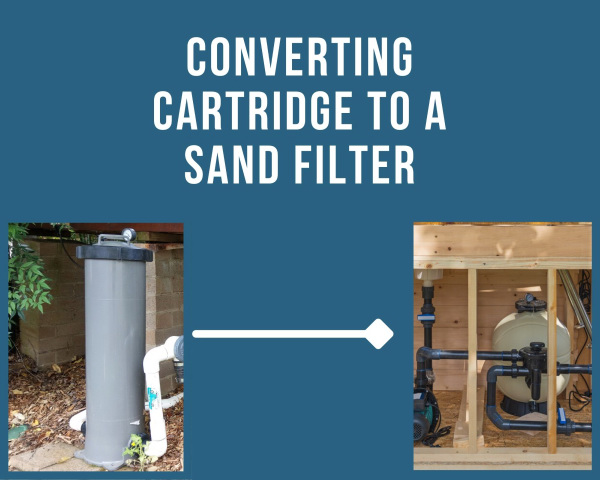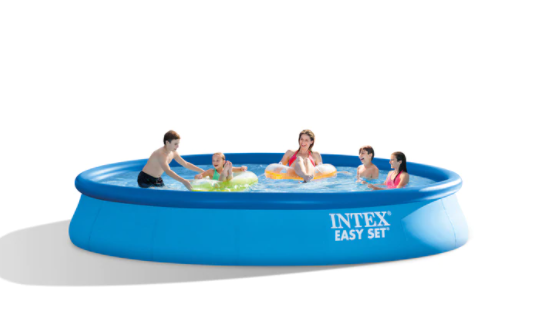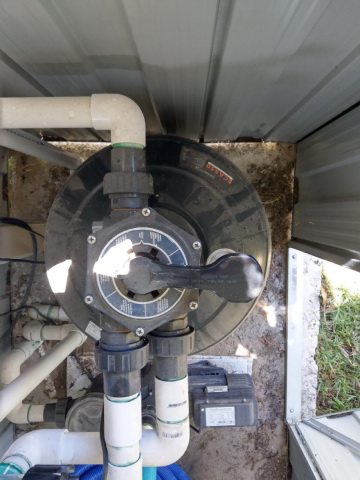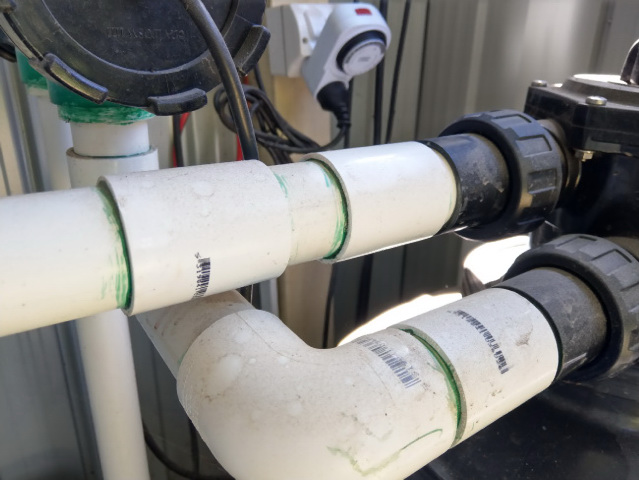Did it take you hours of debate to settle on a cartridge filter for your pool? Or maybe it was a quick decision. Whichever it was, now you’re curious if it’s possible to switch from a cartridge filter to a sand filter.
Converting a pool’s filtration from cartridge to sand is possible with all pools and costs between $500 and $1200 on average, including installation. It’s not as simple as switching out the cartridges for sand, though. To convert to a sand filter, a new sand filter will need to be purchased and the pool plumbing rerouted to suit.
Before you rush to the pool store to stock up on sand, read on to learn about the pros and cons of converting from one to the other. And the best way to swap the systems.

Article Contents
Can You Convert Pool from Cartridge to a Sand Filter?
As mentioned above, it is relatively easy to convert your pool’s filtration system from cartridge to sand. By converting, I mean remove the old cartridge filter unit and replace it with a new sand filter. It’s not possible to reuse the cartridge filter housing and add sand to it (unless you’re a DIY genius and have too much time on your hands!).
A lot of pool owners initially choose a cartridge filter because they are better at filtering out dirty water than sand. However, you may be frustrated with the cleaning and maintenance involved. Cartridge filters require more time and effort than maintaining a sand filter.
Plus, you have to take apart the cartridge filter to clean the cartridges, and that can easily lead to leakages if it’s not properly sealed afterward.
Another type of pool owner who would consider the switch is one who owns an Intex pool. These pools regularly have cartridge filters attached with them. However, the cartridge filter is often underpowered and too small for the size of the pool it’s working on. This means, the water may be cloudy or not as clean as it could be. This is why many switch from an Intex cartridge to a sand filter, for a more efficient clean.

Pros of Converting from Cartridge to Sand Filter
- Reduced cleaning time
- Easy cleaning routine
- Sand lasts longer than cartridges
- No specialized cleaning product needed
- More control of pool functions
To keep cartridges in top condition for as long as possible, you need to spend a couple of hours at a time soaking hosing them down every few weeks before reassembling them inside the filter itself. To clean sand, all that’s needed is a simple switch of the multiport valve (MPV) lever.
A regular maintenance routine with a sand filter is backwash regularly. To do this, change the lever on the Multiport Valve (MPV) from Filter to Backwash. All you need to do is leave it in this position for a couple of minutes. After that, switch it to Rinse for the same amount of time and you’re done.
It’s vital to finish the cleaning process with Rinse to prevent blockages and undue high pressure on the pipes, valve, and filter itself. Still unsure of how to clean a sand filter? Check out this how-to article to become confident in backwashing your pool.
The specialized sand used in sand filters has a lifespan of 5-7 years as the rough edges of the sand wear down over time, needing replacement. Whereas cartridges have a lifespan of 2-3 years, requiring replacement sooner depending on usage. Plus, cartridges are more expensive to replace than sand.
To get a thorough clean of your cartridges, you need to soak them in a specialized filter cleaning solution once or twice a year. A popular solution to choose is muriatic acid which is an added cost to your pool’s routine maintenance. Using any type of acid needs to be carried out safely. Check out here to learn how to clean cartridge filters with muriatic acid responsibly.
A sand filter is outfitted with a multiport valve, as mentioned above. This valve allows you to better control your pool’s functions. If your pool has gathered large debris, like leaves or algae blooms, you can flush out the water with the Waste setting or vacuum to waste. If you want to run through a new chemical without filtering it, you can choose Recirculate. You can’t do that with a cartridge filter.

Cons of Converting from Cartridge to a Sand Filter
- Less efficient filtration
- More upkeep on pool chemical balance
- Cuts energy costs
- Conversion costs
The biggest disadvantage of converting from a cartridge filter to a sand filter is the change of filtration efficacy.
Sand filters take up a much smaller filtration area (2-6 sq. ft) than cartridge filters do (200-600 sq.ft). And sand is a much larger filter medium, which means it isn’t able to trap microscopic dirt under 20 microns, like fine dust. A cartridge filter will filter out smaller contaminants, which means cleaner water that isn’t cloudy. And the fewer contaminants in the water means less sanitizer or chlorine is needed.
Along with taking those additional measures to keep your pool sanitized, you’ll need to keep an eye on the pool chemistry again because of the routine cleaning sand filter requires. Backwashing and rinsing rids the pool of some water which needs to be replaced and rebalanced with chlorine, or whatever sanitizing method you have in place. A sand filter system may not suit those who live in water use restriction areas.
Cartridge filters perform very well at low speeds compared to sand filters. If you have a variable speed pump, you can have a low-running cartridge filter which will prolong the life of the pump. Plus, running everything at a lower speed will cut down on energy costs and also minimize pool equipment noises.
With all conversions or installations, there will be that initial upfront cost to get a sand filter and have it installed. If you’re reasonably competent with DIY, you could do it yourself, though.
What’s Involved When Converting?
Converting from a cartridge filter to a sand filter will take some time and effort, and expertise to carry it out seamlessly. It really is simply a matter of removing the cartridge filter and plumbing in the new sand filter. You may need to move the pool pipes (lines) around to suit though.
What Size Filter to Get?
Before choosing what size sand filter to get, you’ll need to know the power of your pool pump and the volume of your pool. It’s vital you choose a filter that suitably matches the pump power, so there’s no issue with filtration or excess power.
It’s better to err on the side of caution. A larger than needed filter with a small pump is better than a smaller filter with a large overpowered pump. The larger filter will initially cost more. However, you’ll be able to filter more water resulting in a cleaner pool. Plus you won’t have the issue of having an overpowered pump, which can wreak havoc on the inner working of the sand filter.
Excessive power will massively increase the pressure of the water passing through the filter, which can create channels of water through the filter. This means the water runs through the channels instead of going through the sand.
Besides purchasing the new filter unit and sand, you will need to have the pipes re-plumbed to suit the new filter system.
How To Convert from a Cartridge to a Sand Filter
Here’s the steps involved in converting:
1. Purchase the Correct Filter Size
To know what size filter you need, you’ll need to know the volume of the pool and your pool pump flow rate. If you’re unsure of your pool’s volume, we don’t cover that here, but you can find a lot of online calculators to help with this.
You can find the pump’s flow rate on the manufacturer’s website.
Be mindful that all filters have a minimum and maximum flow rate that the pump must fall within. If it’s too low or too high, the filter won’t work correctly.
2. Ensure You Have Enough Space
It might seem like common sense, but giving enough room for your sand filter is important for regular maintenance and repair. Make sure you incorporate enough space on all sides to place your feet and be able to work from.
3. Modify the Plumbing & Install Filter

After you’ve disconnected the old cartridge filter, it’s time to put the sand filter in place. You’ll likely need to reroute the pipes or lines to the inlet and outlet of the filter. PVC piping is the most commonly used, and it’s crucial to attach the correctly sized pipes for the new filter, so the water flow is correct.
Then all you need to do is install the standpipe and laterals in the filter and fill it with pool sand to complete the filter conversion.
4. Test The Installation
After everything has finished being installed, you can run the filtration system on the Filter setting and monitor the pressure gauge (normal is 10 psi) and look for any possible leakages.
Regularly check for the first few weeks that there is no increase in pressure or new leakages to make sure the filter is running smoothly.
Final Thoughts
Realizing that you can change filtration systems is a godsend to many frustrated pool owners. Spending hours cleaning cartridges is frustrating and time-consuming.
Knowing the advantages and disadvantages of converting from cartridge to sand greatly helps solve any hesitations you have. When you’re ready to make the switch, make sure you contact a professional to carry out the changeover and don’t attempt the switch yourself.
Related Reading: What’s the Best Pool Filter? Sand vs. Cartridge vs. DE

